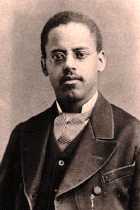
Lewis Howard Latimer
(Sept. 4, 1848 - Dec. 11, 1928)
Lewis Howard Latimer is best known for his work with electric lighting and his invention of the water closet, which made train travel more pleasant.
He was born Sept. 4, 1848 to George and Rebecca Latimer in Chelsea, Mass., just six years after his parents fled slave life in Virginia.
Not long after Lewis was born, his father was arrested and tried as a fugitive slave. With the help of Frederick Douglass, abolitionist William Lloyd Garrison and $400 from an African-American minister, his father was released.
Spending most of his free time working with his father, Lewis also attended grammar school where he developed a love for reading and drawing.
At 16, Lewis falsified his age on his birth certificate to join the U.S. Navy in 1864. At the end of the Civil War, he received an honorable discharged, and in 1868 took a job as an office boy in the Crosby and Gould patent law firm.
By keeping a close eye on the draftsmen and reading books on the subject, he taught himself mechanical drawing.
In 1874, Lewis received a patent of his own for a railroad water closet. At the time, passenger rail cars lacked toilets. His patent for the water closet was only the beginning.
After perfecting his skills in mechanical drawing, Lewis went to work for several prominent inventors.
Lewis worked for Alexander Graham Bell producing a patent drawing for Bell's telephone just hours before Bell's competition.
In 1880, Lewis was hired as a draftsman for the U.S. Electric Lighting Company in Brooklyn, N.Y., by founder Hiram. It was there that Lewis learned about electric incandescent lighting and patented a way of making carbon filaments for the Maxim electric incandescent lamp.
It wasn't long before Lewis caught the eye of Maxim's rival, Thomas Edison. Lewis was in charge of the company library and filing patent forms properly with the U.S. Patent Office for Edison. He later became Edison's patent investigator and expert witness protecting Edison's inventions worldwide.
Under Edison's encouragement, Lewis wrote Incandescent Electric Lighting, A Practical Description of the Edison System in 1890. On Feb. 11, 1918, Lewis became the only African- American to be a charter member of Edison Pioneers, an elite group of 28 people.
In 1922, with the onset of failing eyesight he was forced to end his career. With the death of his wife in 1924, his health began to take a turn as well.
During his life, Lewis taught mechanical engineering, drawing and English to immigrants at the Henry Street Settlement House and was an officer in the Grand Army of the Republic, a Civil War Veteran's organization. On Dec. 11, 1928, Lewis died leaving behind a legacy that will shine bright for years to come. His invention of the water closet, for the train industry, led to longer train rides with fewer stops. And for that, train enthusiasts around the world salute him.